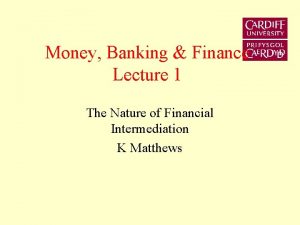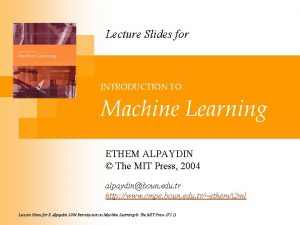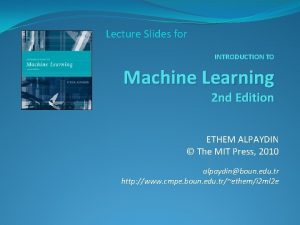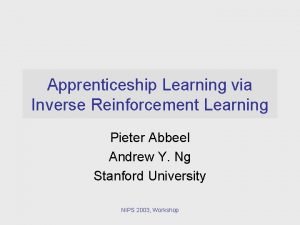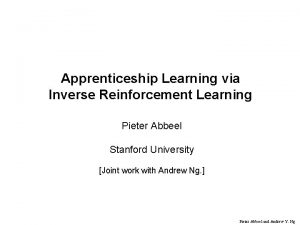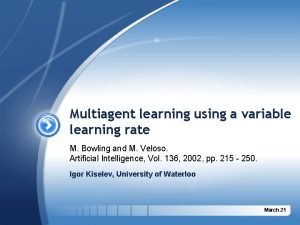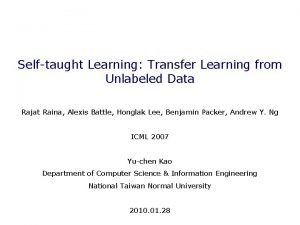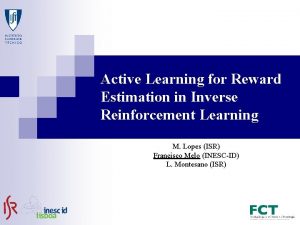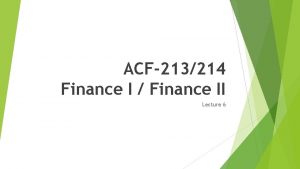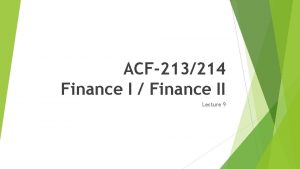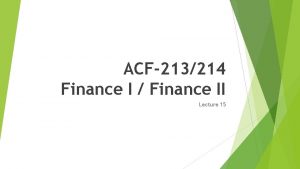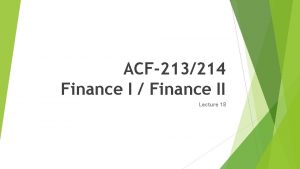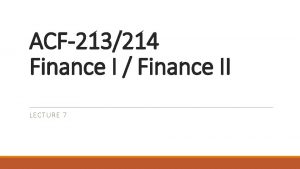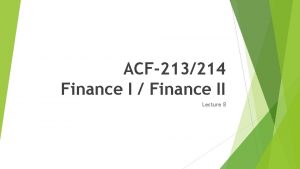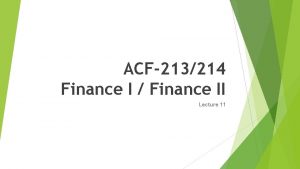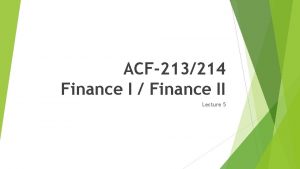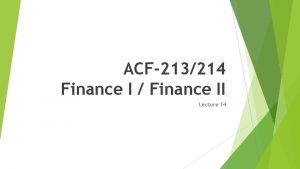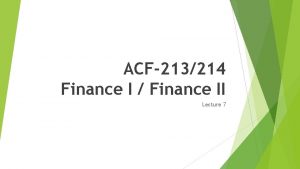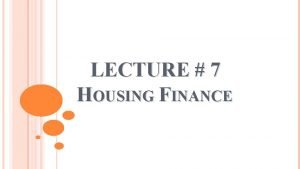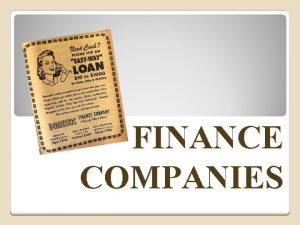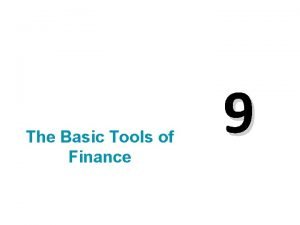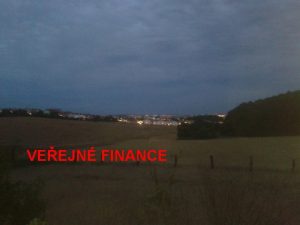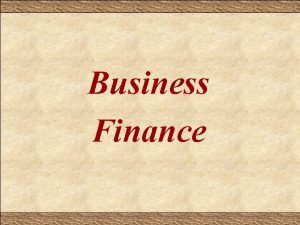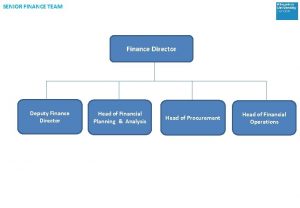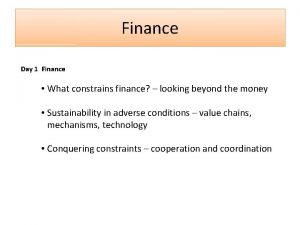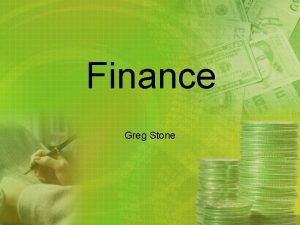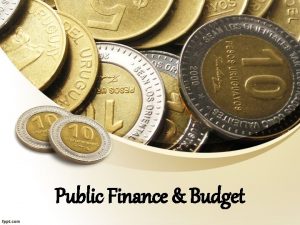ACF213214 Finance I Finance II Lecture 12 Learning






















































- Slides: 54

ACF-213/214 Finance I / Finance II Lecture 12

Learning Outcome Understand the portfolio concept in finance

Topics Covered Calls, Puts, and Shares Financial What Alchemy with Options Determines Option Values?

Topics Covered A Simple Option-Valuation Model The Binomial Method for Valuing Options The Black-Scholes Formula Black-Scholes in Action Option Values at a Glance The Option Menagerie

Topics Covered The Value of Follow-On Investment Opportunities The Timing Option The Abandonment Option Flexible Production and Procurement Investment in Pharmaceutical R&D Valuing Real Options

Calls, Puts, and Shares Terminology Derivatives: Any financial instrument that is derived from another. (e. g. , options, warrants, futures, swaps, etc. ) Option: Gives the holder the right to buy or sell a security at a specified price during a specified period of time. Call Option: The right to buy a security at a specified price within a specified time. Put Option: The right to sell a security at a specified price within a specified time. Option Premium: The price paid for the option, above the price of the underlying security.

Calls, Puts, and Shares Continued Terminology Continued Intrinsic Value: Difference between the strike price and the stock price Time Premium: Value of option above the intrinsic value Exercise Price: (Striking Price) The price at which you buy or sell the security. Expiration Date: The last date on which the option can be exercised. American Option: Can be exercised at any time prior to and including the expiration date. European Option: Can be exercised only on the expiration date.

Figure 20. 5 Financial Alchemy with Options

Figure 20. 6 Strategy of Buying a Call

What Determines Option Values?

Figure 20. 9 Value of a Call Value of a call before its expiration date (dashed line). The value depends on the stock price. It is always worth more than its value if exercised now (heavy line). It is never worth more than the stock price itself.

Figure 20. 10 (a) and (b) The greater the distribution of possible outcomes, relative to the final price of the stock, the higher the value of the option. This is due to the greater potential for profit. Thus, Y will have a higher option price, ceteris paribus.

Figure 20. 11 Amazon Call Option Each of the curved lines shows the value of the option for different initial stock prices. The only difference is that the upper line assumes a much higher level of uncertainty.

Table 20. 2 Call Option

Risk-Neutral Valuation If investors are indifferent to risk, the expected return on the stock must be equal to the risk-free rate of interest: Expected return on Amazon stock = 0. 5% per six months Expected return = [probability of rise × 20%] + [(1 – probability of rise) × (− 6. 667%)] = 0. 5% Probability of rise =. 46815 or 46. 815%

Risk-Neutral Valuation Continued The general formula for calculating the risk-neutral probability of rise in a value: p = interest rate – downside change = r – d upside change – downside change u – d In the case of Amazon: p =. 005 – (– 1. 6667) =. 46815. 20 – (– 1. 6667)

The Binomial Method for Valuing Options Binomial method: Starts by reducing the possible changes in the next period’s stock price to two, an “up” move and a “down” move. Figure 21. 1 illustrates the starting assumptions

Figure 21. 1 Six-Month Price Changes for Amazon Stock (a), (b), and (c)

Example: The Two-Step Binomial Method If investors demand a return of. 25% a quarter, what is the probability (p) at each stage that the stock price will rise? Expected value of call in month 6 = (probability of rise × 264. 72) + (probability of fall × 0) = (. 4774 × 264. 72) + (. 5226 × 0) = $126. 39 Value in month 3 Value today 60. 19/1. 0025 = $60. 05

Figure 21. 2 Amazon Binomial Pricing Present and possible future prices of Amazon stock. Figures in parentheses show the corresponding values of a six-month call option with an exercise price of $900.

The General Binomial Method There is a formula that related the up and down changes to the standard deviation of stock returns.

Figure 21. 3 Amazon Future Prices Present and possible future prices of Amazon stock. (Figures in parentheses show the corresponding values of a six-month call option with an exercise price of $900)

Table 21. 1 Black-Scholes Value of Amazon Call Option As the number of steps is increased, you must adjust the range of possible changes in the value of the asset to keep the same standard deviation.

The Black-Scholes Formula OC = value of call option N(d) = cumulative normal probability function EX = exercise price of option; PV(EX) is calculated by discounting at the risk-free interest rate rf t = number of periods to exercise date P = price of stock now σ = standard deviation period of (continuously compounded) rate of return on stock

Figure 21. 4 Black-Scholes Formula

The Black-Scholes Formula Continued

Using the Black-Scholes Formula Using the Black-Scholes formula applied to value the Amazon call. Price of stock now = P = 900 Exercise price = EX = 900 Standard deviation of continuously compounded annual returns = σ =. 25784 Years to maturity = t =. 5 Interest rate per annum = rf =. 5% for 6 months or about 1% per annum

Step 1 Calculate d 1 and d 2 by plugging numbers into the formula (“log” means natural log):

Step 2 Find N(d 1) and N(d 2) If d 1 is large, N(d 1) is close to 1. 0 If d 1 is zero, N(d 1) is close to 0. 5 Use the Excel function NORMDIST to find N(d 1) and N(d 2)

Step 3 Plug these numbers into the Black-Scholes formula. You can now calculate the value of the Amazon call.

Figure 21. 5 Amazon Call Option The curved line shows how the value of the Amazon call option changes as the price of Amazon stock changes.

Table 21. 2 Black-Scholes Formula

Figure 21. 6 Calculating Implied Volatilities

Option Values at a Glance American calls with no dividends European puts with no dividends American puts with no dividends European calls and puts on dividend-paying stocks American calls on dividend-paying stocks

The Option Menagerie

Chapter Opening: Corporate Options Four Types of “Real Options” 1. The option to expand if the immediate investment project succeeds. 2. The option to wait (and learn) before investing. 3. The option to shrink or abandon a project. 4. The option to vary the mix of output or the firm’s production methods. Value “real option” = NPV with option – NPV w/o option

Table 22. 1 Summary of Cash Flows Mark I Microcomputer ($ millions)

Table 22. 2 Valuing Option to Invest Mark II Microcomputer

Table 22. 3 Microcomputer Forecasts Mark II Microcomputer ($ millions) Forecasted cash flows from 1982

Figure 22. 1 Microcomputer Forecasts Mark II Microcomputer (1985) Distribution of possible present values

Figure 22. 2 Timing Option Example Possible cash flows and end-of-period values for the malted herring project are shown.

Valuing the Malted Herring Option High demand generates $25 million and a value of $250 million at the end of the year. Low demand generates $16 million and no value. High Demand Low Demand Risk-neutral return = 5%

Valuing the Malted Herring Option Continued. The next step requires the calculation of the probability of there being a high demand for the malted herring project. The option value is now determined as follows.

Figure 22. 3 Option to Wait

The Abandonment Option Suppose the crusher project can be abandoned, with recovery of $5. 2 million from the sale of machinery and real estate. We can value the abandonment option as a put. Assume put lasts one year only and the one-year standard deviation of the crusher project is 30% Risk-free interest rate is 4% The asset value is $4. 8 million and exercise price is $5. 2 million

The Abandonment Option Continued Call value =. 49 million or $490, 000 (from B-S formula) Put value = call value + PV(exercise price) – asset value (put-call parity) =. 49 + (5. 2/1. 04) – 4. 8 =. 690, or $690, 000 This means that the project is worth $5. 49 million and abandonment is worth $5. 2 million.

Abandonment Value and Project Life 1. Forecast cash flows beyond the project’s expected economic life. 2. Value the project, including the value of abandonment put, which allows, but does not require, abandonment before year 15.

Figure 22. 4 Oil Tanker

Figure 22. 5 Part 1

Figure 22. 5 Part 2

Figure 22. 6 Aircraft Purchase Option If implemented at year 3, option guarantees fixed price and delivery at year 4 Without option, plane can still be ordered at year 3 but with uncertain price and delivery

Figure 22. 7 Aircraft Purchase Option Value of aircraft purchase option—the extra value of the option versus waiting and possibly negotiating a purchase later. The purchase option is worth most when NPV of purchase now is about zero and the forecasted wait for delivery is long.

Figure 22. 8 Investment in Pharmaceutical R&D

Practical Challenges Practical reasons why real options are not always feasible to use: 1. Valuation of real options can be complex, and sometimes it is impossible to arrive at the “perfect” answer. 2. Real options do not always have a clear structure for their path and cash flows. 3. Competitors also have real options that can alter the value of your options by altering the underlying assumptions and environment that serve as the basis of your valuation. Given these limitations, real options are not always the best approach when valuing projects.
 01:640:244 lecture notes - lecture 15: plat, idah, farad
01:640:244 lecture notes - lecture 15: plat, idah, farad Cuadro comparativo e-learning m-learning b-learning
Cuadro comparativo e-learning m-learning b-learning Banking and finance lecture
Banking and finance lecture Machine learning introduction slides
Machine learning introduction slides Ethem alpaydin
Ethem alpaydin Machine learning lecture notes
Machine learning lecture notes Supervised learning dan unsupervised learning
Supervised learning dan unsupervised learning Concept learning task in machine learning
Concept learning task in machine learning Analytical learning in machine learning
Analytical learning in machine learning Non associative learning meaning
Non associative learning meaning Lazy and eager learning in machine learning
Lazy and eager learning in machine learning Conceptual learning definition
Conceptual learning definition Inductive vs analytical learning
Inductive vs analytical learning Apprenticeship learning via inverse reinforcement learning
Apprenticeship learning via inverse reinforcement learning Apprenticeship learning via inverse reinforcement learning
Apprenticeship learning via inverse reinforcement learning Inductive reasoning
Inductive reasoning Pac learning model in machine learning
Pac learning model in machine learning Jelaskan perbedaan unsupervised dan supervised learning
Jelaskan perbedaan unsupervised dan supervised learning Pac learning model in machine learning
Pac learning model in machine learning Inductive and analytical learning in machine learning
Inductive and analytical learning in machine learning Instance based learning in machine learning
Instance based learning in machine learning Inductive learning machine learning
Inductive learning machine learning First order rule learning in machine learning
First order rule learning in machine learning Collaborative learning vs cooperative learning
Collaborative learning vs cooperative learning Alternative learning system learning strands
Alternative learning system learning strands Active and passive learners
Active and passive learners Multiagent learning using a variable learning rate
Multiagent learning using a variable learning rate Deep learning vs machine learning
Deep learning vs machine learning Tony wagner's seven survival skills
Tony wagner's seven survival skills Self-taught learning: transfer learning from unlabeled data
Self-taught learning: transfer learning from unlabeled data Active learning reinforcement learning
Active learning reinforcement learning Project procurement management lecture notes
Project procurement management lecture notes Lecture about sport
Lecture about sport Lecture on healthy lifestyle
Lecture on healthy lifestyle Nihilism vs existentialism
Nihilism vs existentialism Life lecture meaning
Life lecture meaning Randy pausch the last lecture summary
Randy pausch the last lecture summary Tensorflow lecture
Tensorflow lecture Theology proper lecture notes
Theology proper lecture notes Strategic management lecture
Strategic management lecture Geology lecture series
Geology lecture series Social psychology lecture
Social psychology lecture In text citation for a lecture
In text citation for a lecture Public sector accounting lecture notes
Public sector accounting lecture notes Lecture notes on project management
Lecture notes on project management Practical design to eurocode 2 lecture 3
Practical design to eurocode 2 lecture 3 Electricity and magnetism lecture notes
Electricity and magnetism lecture notes Classical mechanics
Classical mechanics What is a harmonic wave in physics
What is a harmonic wave in physics Physical science lecture notes
Physical science lecture notes Power system dynamics and stability lecture notes
Power system dynamics and stability lecture notes Natural language processing nlp - theory lecture
Natural language processing nlp - theory lecture Microbial physiology notes
Microbial physiology notes Application of mechatronics ppt
Application of mechatronics ppt Ternology
Ternology


